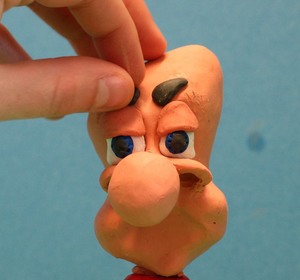Making a Claymation or stop-motion animation is easier than you think. Whether you dream of one day unleashing your animated madness on the world, or you’re just looking for an extremely time consuming hobby, an introduction to stop motion animation could be for you.
So you’ve decided to become the next Aardman. You will need some digital electronic equipment, and a whole mess of supplies.
We’ll start with the expensive end; the digital equipment, because all the sets and intricate moving figures in the world will not in of themselves become a playable movie. Stop motion animation can be captured using a digital still camera or a digital video camera. In my experience, I prefer using a digital video camera, simply for the larger storage capacity for frames when captured as three second clips.
Once you have your capturing device, you will need software. My personal preference is for Adobe Premier, although versions above 6.5 have ceased to carry the stop motion capture feature. For a list of alternate video editing programs and possible camera options, visit
For a detailed description of the stop motion capture process in Adobe Premier, visit here.
Once you have determined how you are going to capture and digitize your movie, the next step is to have something to film. But before we get into an extended project, you should do a few test runs. Start with balls of clay transforming into other shapes. This step is important. You will most likely find that the seemingly massive amount of frames taken for a few simple movements are completely insufficient. This is perfectly normal, because it is a painstaking goal that you are trying to achieve. When filming at thirty frames a second, movements become minuscule. If you have difficulty with this, you can film as low as fifteen frames a second without serious loss of fluidity.
Once you have developed a sense of timing for the process, it is time to embark on your complete Claymation. The very first thing you must do is plan every second of the film in advance. This sounds burdensome, but it is easy taken one step at a time. Start with a story and visualize the scenes involved. Create a storyboard, which is a loosely drawn comic strip laying out the shots of the movie. Make notes about the small movements and details of the action. Trust me; the more you plan, the smaller the headaches will be when you get to filming.
You will need an off-limits space where light can be completely controlled. If you don’t have a closet large enough to work in, make sure the stage is set in an area that has no outside light and is unreachable by children, pets, or friends. The slightest, most insignificant bump at the wrong time can ruin day’s worth of work.
Create a small set. The size is entirely up to you, but smaller figures means less material and less space needed for production. This is just like creating a set for any film or television show. The areas necessary depend on the shots planned. If you plan on shooting at an upward angle for example, you will need a ceiling. If you are planning only a single downward shot, you will only need a floor and one or two walls. Your goal is to create the illusion of a functional space.
You will now need characters. For beginners, simple wire armatures, or sculptural skeletons should be used. The goal is to create a literal skeleton for your character by twisting bendable wire together. Make sure the wire is ridged enough to hold up the figure and flexible enough to bend in minimal increments. Glue small, flat magnets to the feet of the skeleton for walking characters, although walking a character is an advanced trick and difficult to achieve as a beginner.
Oil clay is traditionally used for Claymation, but it is messy and difficult to mix colors. For beginners, I recommend using Sculpey polymer clay, which is as pliant as oil clay but also easy to mix. The one drawback is that Sculpey will loose some of it’s elasticity after several months. Mold the clay around the metal skeleton and finish details as desired.
Now the true fun can begin; filming the movie. Mount you camera on a rock-sturdy tripod and attach it to something heavy if possible. Since touching the tripod can invariably lead to jumps in continuity, a device with a remote control is essential.
Begin filming and watch as the days fly by! Seriously though, take it one scene at a time, and follow your own instructions (You did remember to plan and make instructions, right?) Keep on your task, and don’t be afraid to cut some scenes from the filming when you realize just how enormous of a task your twenty minute prospective movie really is.
For a detailed description of the stop motion capture process in Adobe Premier, visit www.ryerson.ca/rta/handbook/animation_guides/stop_motion_setup_guide.htm
The process is tedious, monotonous, and sometimes even mind numbing. But remember, you’re doing this because you love it. There is no other good reason to embark on the wild, anachronistic seas of Claymation.

